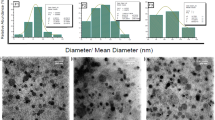Abstract
The pharmacokinetics of Zn-phthalocyanine (Zn-Pc) in mice bearing a transplanted MS-2 fibrosarcoma has been studied using dipalmitoyl-phosphatidylcholine (DPPC) liposomes and low density lipoproteins (LDL) as drug delivery systems. LDL induce a higher Zn-Pc uptake by the tumour and improve the selectivity of tumour targeting as compared to DPPC liposomes. Experimental photodynamic therapy (PDT) of the MS-2 fibrosarcoma has been performed using liposome-delivered Zn-Pc and the efficiency of tumour necrosis has been measured following four different irradiation protocols. We found that Zn-Pc doses as low as 0.07-0.35 mg kg-1 are sufficient for inducing an efficient tumour response that is linearly dependent on the injected dose. The amount of Zn-Pc in the tumour decreases very slowly as a function of time, hence PDT gives satisfactory results even if performed at relatively long time intervals after administration.
This is a preview of subscription content, access via your institution
Access options
Subscribe to this journal
Receive 24 print issues and online access
$259.00 per year
only $10.79 per issue
Buy this article
- Purchase on Springer Link
- Instant access to full article PDF
Prices may be subject to local taxes which are calculated during checkout
Similar content being viewed by others
Author information
Authors and Affiliations
Rights and permissions
About this article
Cite this article
Reddi, E., Zhou, C., Biolo, R. et al. Liposome- or LDL-administered Zn (II)-phthalocyanine as a photodynamic agent for tumours. I. Pharmacokinetic properties and phototherapeutic efficiency. Br J Cancer 61, 407–411 (1990). https://doi.org/10.1038/bjc.1990.89
Issue Date:
DOI: https://doi.org/10.1038/bjc.1990.89
This article is cited by
-
Behavior of anchor functionalized ZnPc molecules on a graphene nanoflake near membrane cell
Structural Chemistry (2020)
-
Phthalocyanine conjugates with carbohydrates: synthesis and aggregation in aqueous solutions
Russian Chemical Bulletin (2013)
-
Structural and physico-chemical determinants of the interactions of macrocyclic photosensitizers with cells
European Biophysics Journal (2007)
-
Photodynamic therapy of experimental tumours with Zn(II)-phthalocyanine and pulsed laser irradiation
Lasers In Medical Science (1995)
-
Photodynamic efficiency of liposome-administered tetramethyl hematoporphyrin in two human bladder cancer cell lines
Urological Research (1995)



